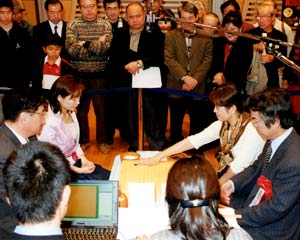| ■Ricoh Cup Quarterfinals and Semifinals |
| "Jikantsunagi (Time Holding)" Tactics |
| In this year's Ricoh Cup Tournament, there is a tense atmosphere that has not been felt in the previous tournaments. This is mainly due to the rich contents of the games. As an example, the tactics of jikantsunagi or time holding is often used in an efficient way. |
| Essentially, jikantsunagi is not considered a legitimate play. During countdown at the limited time for consideration, jikantsunagi is occasionally used to compute the number of stones in difficult mutual attack or determine which area is larger in yose. It can be said that this tactics is an emergency means because it reduces ko materials. |
| This year, however, jikantsunagi or similar play is sometimes seen in the middle phase of games even if the situation is not difficult. Players use this tactics when they cannot clearly understand what a move made by their partner in the middle phase is intended for. By playing "kikashi that causes a minimum loss", players try to let their partner pursue his or her idea or to leave the concept in the middle phase up to their partner. Such uses of this tactics may be an evidence that pair Go is evolving. |
| During the initial the Ricoh Cup tournaments, it was pointed out that the paired players should get along well together to win the game. Conversely, there were many moves reflecting poor partnership on the board. Recently, however, there are few teams that make you feel as if one's arms and legs were moving inconsistently due to the lack of combination. If jikantsunagi is used to maintain the pair's entire concept or intention in the game, it can be called a good tactics in pair Go. |
 |